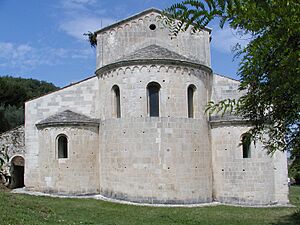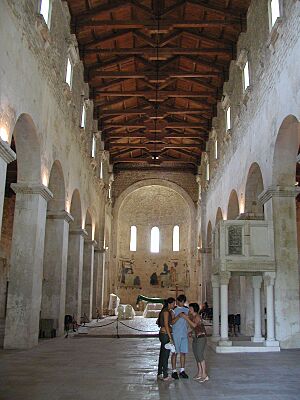San Liberatore a Maiella facts for kids
San Liberatore a Maiella is an old abbey and church located in Serramonacesca, a town in the Pescara province of Abruzzo, Italy. An abbey is a special building where monks or nuns live and worship. This church is a beautiful example of ancient Italian architecture.
Contents
A Look Back: The Abbey's History
The story of San Liberatore a Maiella is very old. People say it was first built around the time of Charlemagne, a famous emperor from long ago. You can even see a painting of him inside the church!
Building and Rebuilding Through the Centuries
The first version of the church was built in the 800s. Then, in 1007, a Benedictine monk named St. Theobald helped rebuild it. Benedictine monks are part of a very old Christian group. The church was meant to honor "St. Liberator," but it actually honors Jesus the Liberator.
Later, around 1080, the church was rebuilt again. This time, it was done by Desiderius, who was the abbot (leader) of a very important monastery called Montecassino.
Modern Restoration Efforts
For many years, the church was not in good shape. It was falling apart. But thankfully, it was carefully restored between 1967 and 1971. This work helped bring the beautiful old building back to life for everyone to see and enjoy today.
Exploring the Abbey's Architecture
The San Liberatore a Maiella abbey has a striking white front, called a façade. It looks very balanced and grand. Next to it stands a square bell tower with three levels. Each level has different windows: one window on the bottom, two windows together in the middle, and three windows together at the top. This style is called Lombard-Romanesque, which was popular a long time ago.
When you go inside, the church is laid out like a "basilica." This means it has a main central area called a nave, and two side areas called aisles. These areas are separated by seven round arches.
The main arches, which used to lead to the altar area (called the presbytery), are supported by strong pillars. These pillars have cool decorations, similar to the walls of the nave. Look up, and you'll see a wooden ceiling!
Special Features and Art
On the left side of the church, there are two decorated doors. These used to lead to the cloister (an open courtyard) and the living areas for the monks. One door has a special flower design, which is a common style in this region.
The floor in the nave is also very interesting. It has a rare pattern of geometric shapes that dates back to about 1200.
The apse, which is the rounded part at the end of the church where the altar is, has old paintings called frescoes. These frescoes are from different times. One painting of Theobald is from the 1500s, and another, with parts of saints, is even older, from the 1100s.
You'll also see a square-shaped ambo, which is a raised stand where readings are given. It looks similar to those found in other famous abbeys nearby, like the San Clemente Abbey and San Pelino at Corfinio.




